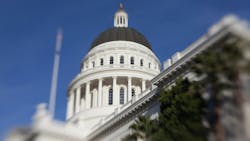Bay Area transit sales tax proposal gets approval from California governor to advance toward 2026 ballot
California Gov. Gavin Newsome pushed forward a possible funding solution for Bay Area transit agencies Monday by signing Senate Bill (SB) 63, a bill that would allow for the next steps in the process for five area counties to add a 14-year regional transportation sales tax measure to the November 2026 ballot to fend off looming fiscal cliffs.
Introduced by state Sens. Scott Wiener (D-San Francisco) and Jesse Arreguin (D-Berkley), Alameda, Contra Costa, San Francisco, San Mateo and Santa Clara counties would ask voters to approve a half cent tax, except in San Francisco, who would be assessed a full cent tax, to secure funding for local transit agencies in the face of lower post-pandemic ridership figures. The measure, if passed, would generate approximately $980 million annually across the five counties for the transit agencies.
“We’re excited the Connect Bay Area Act is moving forward and voters will soon have the opportunity to shape the future of public transit along the Peninsula and surrounding Bay Area communities,” said San Mateo County Transit District (SamTrans) Board Chair Jeff Gee. “Next November’s vote will be a pivotal moment to secure reliable, connected and sustainable transportation. With this measure, we can ensure SamTrans, Caltrain and our regional transit partners have the stable funding needed to serve riders for years to come.”
Along with his signature, Gov. Newsome released a statement, sharing understanding for the difficulty of managing a local transit system from his time as both a mayor and supervisor, though noting that the public’s willingness to “support repeated taxes cannot be assumed.”
The governor’s signature doesn’t automatically add the measure to the ballot. Instead, it allows the measure to move to the ballot in one of two ways. First, the newly formed Public Transit Revenue Measure District governed by the Metropolitan Transportation Commission (MTC) can push the measure to the ballot, however, this method could pose more difficult as new special taxes, like that of funding transit, require a two-thirds majority to be approved via this method according to California state law. The second method is via a voter-initiated measure, a move that would only require a simple majority to pass.
If passed, just shy of two thirds of the funding would be dedicated to the preservation of service on Bay Area Rapid Transit (BART), San Francisco Municipal Transportation Agency, Caltrain, Alameda-Contra Costa Transit District (AC Transit), San Francisco Bay Ferry and other smaller area transit services—agencies that are facing an $800 million deficit starting in fiscal year 2027-28 according to independent review. The remaining third would go to the Santa Clara Valley Transportation Authority (Santa Clara VTA), SamTrans, the Alameda County Transportation Commission (ACTC) and the Contra Costa Transportation Authority (CCTA) to use flexibly for anything from capital projects to operations, or road paving projects for their bus routes.
Attached to the new funding would be requirements for independent oversight of the use of funds. One committee would be comprised of a representative from each of the participating counties that would ensure that funding is being spent in line with the law. Another set of committees would be designed for BART, Muni, Caltrain and AC Transit to create a two-phase independent third-party review of the efficiency of their financials. The committee would host four independent experts, board representatives from each of the four operators one transit agency representative, one department of finance representative and a commissioner from the MTC.
Additionally, the measure would require agencies to maintain existing levels of funding for operating purposes should the measure pass. The requirement was set forth to ensure the new funding wasn’t replacing existing means, but adding to them to fight off the potential funding crisis.
Agencies are in favor of the measure, citing sluggish post-pandemic ridership figured for the funding challenges.
"The BART Board of Directors supported SB 63 because it will cover a significant portion of BART’s operating deficit caused by remote work and will allow us to maintain current service levels and improve the rider experience," said BART General Manager Bob Powers.
Other agencies have shared how the measure would complement adjustments they’ve already been making to ensure their financial footing.
“Through Gov. Newsom’s leadership and the support of voters, SB 63 will help protect transit for our more than three million monthly riders,” said AC Transit Board President Diane Shaw. “In fact, this summer, we took proactive steps to preserve service by redesigning 103 bus lines through our new Realign Network. Designed over two years, this all-new network maintains service at 85% of pre-pandemic levels. SB 63 gives voters a chance to ensure that these vital bus lines—and our riders’ lifelines—are protected for the future.”
About the Author
Noah Kolenda
Associate Editor
Noah Kolenda is a recent graduate from the Craig Newmark Graduate School of Journalism with a master’s degree in health and science reporting. Kolenda also specialized in data journalism, harnessing the power of Open Data projects to cover green transportation in major U.S. cities. Currently, he is an associate editor for Mass Transit magazine, where he aims to fuse his skills in data reporting with his experience covering national policymaking and political money to deliver engaging, future-focused transit content.
Prior to his position with Mass Transit, Kolenda interned with multiple Washington, D.C.-based publications, where he delivered data-driven reporting on once-in-a-generation political moments, runaway corporate lobbying spending and unnoticed election records.

